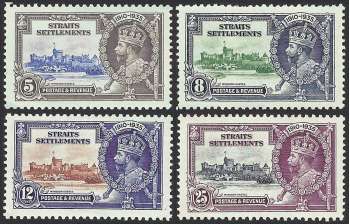STAMP PHILATELY
Straits Settlements - King George V Silver Jubilee 1910-1935 (Set)
GENERAL INFORMATION
Country
Straits Settlements
Type
Stamp (Complete Set)
Class
Special Issue
Front Inscription
STRAITS SETTLEMENTS POSTAGE & REVENUE WINDSOR CASTLE
Issued Date
06/05/1935
Printer
De La Rue & Co, Limited (UK)
Printing Method
Typography
Gum
Gum
Dimension
43 × 27 mm
Perforation Gauge
11 x 12
IN COLLECTION CONDITION
Preliminary
Normal
Condition
Mint Hinged - Extra Fine
CATALOG INFORMATION
238
Standard Stamp Catalog of Malaysia, Singapore & Brunei
239
Standard Stamp Catalog of Malaysia, Singapore & Brunei
240
Standard Stamp Catalog of Malaysia, Singapore & Brunei
241
Standard Stamp Catalog of Malaysia, Singapore & Brunei
Straits Settlements - King George V Silver Jubilee 1910-1935 (Set)
BACKGROUND
The idea of producing commemorative stamps to mark the Silver Jubilee of King George V originally came from the Colonial Office, with the suggestion that an identical set should be issued throughout the Empire on 10 May 1935. The Post Office was initially unenthusiastic, as work was underway on a new set of definitives, and it was known that the King did not particularly approve of commemorative issues.
However, the Director of Postal Services eventually agreed that this was the best way for the Post Office to participate in the Jubilee celebrations, and in June 1934 it was decided that four values, ½d, 1d, 1½d and 2½d, should be issued.
DESIGN & PRODUCTION PROCESS
Selection consultations took place between Colonel Sir Donald Banks, Director General, Sir Stephen Tallents, GPO Public Relations Officer, and Kenneth Clark, Director of the National Gallery. Artists were invited to submit designs for one value, with a view to producing designs for the full set if selected.
As this would be the first special issue to be produced by photogravure, which reproduces a number of graduated tones, designs were requested in shades of grey. The GPO suggested royal homes, buildings, scenes and events of Imperial significance as possible subjects.
Twelve designs were submitted unsuccessfully, but a second round of submissions produced one satisfactory design, which was by Barnett Freedman. This was essayed using alternative portraits of the George V, by Vandyk and Mackennel, and in two sizes. The King chose the Mackennel head, on landscape stamps twice the size of standard definitives.
ISSUED STAMPS
The chosen colours corresponded with the definitives. Thoughts had been given to issuing the 2½d in turquoise (known to collectors as 'Prussian blue') instead of ultramarine: essays were produced, but the idea was abandoned. However, Harrisons inexplicably printed many sheets in the incorrect colour. Most were destroyed, but five were delivered to the Stores Department, and at least three were accidentally issued to Upper Edmonton Post Office, where they were sold in the normal way.
The stamps were issued on 7 May 1935 in sheets, and, with the exception of the 2½d value, in 2/- and 3/- booklets. The booklet panes comprised four stamps, and the covers were also designed by Freedman. The stamps were also overprinted for use in the Morocco Agencies and Tangier.
The idea of producing commemorative stamps to mark the Silver Jubilee of King George V originally came from the Colonial Office, with the suggestion that an identical set should be issued throughout the Empire on 10 May 1935. The Post Office was initially unenthusiastic, as work was underway on a new set of definitives, and it was known that the King did not particularly approve of commemorative issues.
However, the Director of Postal Services eventually agreed that this was the best way for the Post Office to participate in the Jubilee celebrations, and in June 1934 it was decided that four values, ½d, 1d, 1½d and 2½d, should be issued.
DESIGN & PRODUCTION PROCESS
Selection consultations took place between Colonel Sir Donald Banks, Director General, Sir Stephen Tallents, GPO Public Relations Officer, and Kenneth Clark, Director of the National Gallery. Artists were invited to submit designs for one value, with a view to producing designs for the full set if selected.
As this would be the first special issue to be produced by photogravure, which reproduces a number of graduated tones, designs were requested in shades of grey. The GPO suggested royal homes, buildings, scenes and events of Imperial significance as possible subjects.
Twelve designs were submitted unsuccessfully, but a second round of submissions produced one satisfactory design, which was by Barnett Freedman. This was essayed using alternative portraits of the George V, by Vandyk and Mackennel, and in two sizes. The King chose the Mackennel head, on landscape stamps twice the size of standard definitives.
ISSUED STAMPS
The chosen colours corresponded with the definitives. Thoughts had been given to issuing the 2½d in turquoise (known to collectors as 'Prussian blue') instead of ultramarine: essays were produced, but the idea was abandoned. However, Harrisons inexplicably printed many sheets in the incorrect colour. Most were destroyed, but five were delivered to the Stores Department, and at least three were accidentally issued to Upper Edmonton Post Office, where they were sold in the normal way.
The stamps were issued on 7 May 1935 in sheets, and, with the exception of the 2½d value, in 2/- and 3/- booklets. The booklet panes comprised four stamps, and the covers were also designed by Freedman. The stamps were also overprinted for use in the Morocco Agencies and Tangier.
COMMENTS
NEW COMMENT
|
The following text must accompany any text or photo taken from this page and limited use for non-commercial purposes only.
Texts and Images were taken from and courtesy of Exonumi.com
URL: http://www.exonumi.com/publish-SP.1.424
|
|
